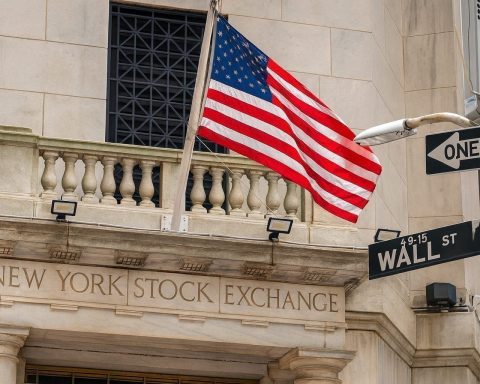- Skyrocketing Stock: BigBear.ai Holdings (NYSE: BBAI) shares have surged nearly 300% in 2025, briefly hitting multi-year highs around $9.39 in mid-October after a 22% single-day jump on a new defense AI deal [1] [2]. The volatile small-cap has since pulled back to the mid-$6–$7 range (recent close ~$6.78 on Oct. 28), still roughly double its price at the start of the year [3] [4].
- New Defense Deals: BigBear.ai’s rally is fueled by high-profile government tech contracts. On Oct. 13, it partnered with Tsecond to deploy AI-enabled “edge” infrastructure for U.S. military use [5]. Shortly after, BigBear’s veriScan facial recognition system went live at Chicago O’Hare Airport on Oct. 23, slashing international arrival processing times from ~60 seconds to 10 seconds [6]. These wins – along with a September U.S. Navy surveillance project (with partner SMX) and biometric screening rollouts at major airports – showcase BigBear’s expanding role in defense and homeland security [7] [8].
- Mixed Financials: Latest earnings highlight growth challenges behind the hype. Q2 2025 revenue fell ~18% year-over-year to $32.5 million, and one-time accounting charges drove a massive $228.6 million net loss in the quarter [9]. Management slashed full-year 2025 revenue guidance to $125–$140 million (down from ~$155 M) and withdrew profit forecasts amid project delays [10]. On the brighter side, BigBear ended Q2 with a $390 million cash war chest and a record $380 million contract backlog, providing liquidity and future revenue visibility despite ongoing losses [11] [12].
- Analysts Divided: Wall Street is cautious on BBAI’s valuation after the run-up. The consensus rating is “Hold” with an average 12-month price target around $6 – below the current market price [13] [14]. H.C. Wainwright remains bullish, reiterating a Buy and recently trimming its target to $8 (from $9) on BigBear’s “strengthened balance sheet” and the tailwind of massive federal AI spending [15] [16]. But others warn the stock (at ~13× forward sales) “already prices in a lot of optimism” [17]. A Simply Wall St model pegs fair value near $5.83, implying the stock is ~20% overvalued at recent levels [18].
- AI Sector Context: BigBear.ai is often touted as a “mini-Palantir” in defense analytics [19]. Its larger peer Palantir (PLTR) has similarly soared ~300% in 2025, riding a wave of government AI spending, and trades near record highs [20]. However, BigBear’s scale is far smaller (≈$30 M quarterly revenue vs. Palantir’s billions) and its gross margins (~25%) pale next to Palantir’s ~80% [21]. Rival C3.ai (NYSE: AI) also targets defense AI contracts but recently saw revenue decline 19% with large losses, highlighting industry growing pains [22]. With Washington pouring hundreds of billions into defense-tech (via the new “OB3” federal AI funding bill) [23], BigBear’s deep government ties give it an opportunity – but execution risks remain high in this competitive, hype-fueled sector [24] [25].
Recent Developments: Defense Deals Drive Optimism
BigBear.ai’s status as a pure-play “AI for defense” contractor has been reinforced by a string of new deals in recent weeks. On October 13, the company announced a strategic partnership with Silicon Valley firm Tsecond Inc. to deliver AI-enabled edge computing hardware for U.S. national security missions [26]. The plan integrates BigBear’s ConductorOS software with Tsecond’s rugged BRYCK data modules, allowing military and intel teams to run AI analytics on the battlefield in real time without needing cloud connectivity [27] [28]. BigBear’s CEO, former DHS chief Kevin McAleenan, said the goal is to provide “mission-ready AI at the tactical edge” so warfighters can detect threats faster even in disconnected environments [29] [30]. Investors cheered the news – BBAI stock spiked 22% the next trading day, reflecting hopes that BigBear can secure a bigger slice of the Pentagon’s tech spending [31] [32].
Later in October, BigBear.ai showcased its technology in civilian security. The company’s veriScan biometric system, which uses AI-driven facial recognition to speed identity checks, was deployed at Chicago’s O’Hare International Airport on Oct. 23 [33]. Early results were striking: processing times for international arrivals dropped from about 60 seconds to 10 seconds with the automated screening [34]. This follows BigBear’s rollout of veriScan at other airports (e.g. Nashville International in Q3) as the U.S. government upgrades homeland security and travel infrastructure with AI [35] [36]. Around the same time, BigBear and partner SMX provided AI-powered analytics for the U.S. Navy’s UNITAS 2025 naval exercises, helping allied fleets track illicit maritime activity via unmanned systems [37]. These deployments – spanning military, aviation, and border security – demonstrate BigBear’s expanding footprint in real-world operations and bolster its reputation as a go-to vendor for defense and intelligence AI solutions [38] [39].
BigBear.ai has also been shoring up its capabilities behind the scenes. Its board appointed Sean R. Ricker as permanent Chief Financial Officer on Oct. 14, after several months with Ricker in an interim role [40]. This leadership move comes as the company eyes potential acquisitions or strategic investments, armed with an unusually large cash reserve of nearly $400 million [41]. Management has hinted that mergers and acquisitions (M&A) could be on the table to accelerate growth or add new technologies [42] [43]. With a robust pipeline of government projects (including a 5-year, $165 M Army contract for force management systems won last year) [44], BigBear appears to be positioning itself to capitalize on the defense sector’s rush into AI – potentially even expanding overseas via partnerships in regions like the Middle East and Latin America [45]. Each new contract win feeds the bullish narrative that BigBear could become an agile frontrunner in the defense-tech boom – a smaller counterpart to incumbents like Palantir that already serve U.S. intelligence agencies [46]. “BigBear’s stock has soared this year because Wall Street sees continued growth opportunities as the Pentagon aggressively modernizes with AI,” noted one InvestorsObserver report [47].
Stock Performance: Rally, Retreat, and Wild Swings
BBAI’s stock price has been on a rollercoaster in 2025, delivering both exhilarating gains and gut-check volatility. Shares began the year in penny-stock territory and more than doubled between January and mid-February, fueled by retail trader enthusiasm for AI names [48] [49]. In fact, BigBear briefly rocketed to about $10.36 in February amid a meme-stock style frenzy that catapulted many small-cap AI plays [50]. (That surge, driven by social media buzz rather than fundamentals, quickly fizzled – teaching early investors a hard lesson in volatility [51].) After pulling back sharply in the spring, BBAI found a second wind over the summer and into fall as real contract news started rolling in [52].
The stock’s latest eruption came in October. On Oct. 13, BigBear’s Tsecond partnership announcement sparked a one-day +22% spike, with the stock leaping from the mid-$7s to around $8.80 [53] [54]. By the next day (Oct. 14), BBAI hit an intraday high of $9.39 – its highest price in years – amid frenzied trading volumes nearly double the three-month average [55] [56]. At that moment, BigBear stood over 100% higher than its New Year’s price, capping a remarkable year-to-date run [57] [58]. However, the euphoria was short-lived. As traders rushed to lock in profits, BBAI slipped back below $8 in late October [59] [60]. By October 24, it closed around $7.05, and by Oct. 28 the stock settled near $6.78 (-4.5% on the day) amid broader market jitters [61] [62]. In other words, almost the entire early-October pop had retraced by month’s end, exemplifying how quickly sentiment can swing on this high-beta stock.
Notably, trading activity has been feverish throughout BigBear’s ride. On big news days, volume has exploded – for instance, 356 million shares changed hands on Oct. 28 when BBAI fell back to $6.78 [63] [64], a staggering 275% above its typical volume. Such spikes suggest a mix of retail traders, algorithmic momentum funds, and possibly short-sellers piling in. BigBear has indeed attracted “meme stock” attention at times, with a significant portion of its float sold short (around 27% as of mid-October, according to one Motley Fool report) and social media chatter treating it as a speculative AI bet [65] [66]. This dynamic creates the potential for dramatic short squeezes and pullbacks in rapid succession. In 2025, double-digit daily moves in BBAI became almost routine [67]. The stock’s beta (volatility relative to the market) sits above 3.4 [68], reflecting outsized sensitivity to news and trader sentiment. For investors, the takeaway is clear: BigBear.ai can deliver outsized gains, but with equally outsized risk and turbulence. Managing position size and expectations remains key when riding this AI rollercoaster.
Financial Health Check: Big Losses, Big Backing
Behind BigBear.ai’s surging share price lies a financial picture that is mixed at best. The company’s Q2 2025 results (reported in August) revealed declining revenues and deepening losses despite the upbeat contract news. Revenue for the quarter was $32.5 million, down ~18.3% from a year prior [69] [70]. Management attributed the drop partly to timing issues on certain Army data projects, highlighting BigBear’s dependence on the schedules of large federal programs [71] [72]. More glaring was the bottom line: BigBear posted a net loss of $228.6 million for Q2, versus a $14.4 M loss in Q2 2024 [73]. This 16× surge in net loss was driven by major one-time charges – specifically, the revaluation of a convertible note (about $135.8 M) and a goodwill write-down (~$70.6 M) that together skewed the quarter’s results [74] [75]. Even excluding those accounting hits, the company was firmly in the red on an operating basis (adjusted EBITDA was –$8.5 M) [76]. BigBear’s net profit margin for the quarter plunged to –269% [77], underlining that it spent nearly $3 for every $1 in sales.
In response to these challenges, BigBear’s leadership moved to reset expectations. In Q2’s aftermath, they cut the full-year 2025 revenue forecast to $125–$140 M (essentially flat to down vs. 2024) and withdrew any timetable for reaching profitability [78] [79]. Previously, the company had hoped for modest growth this year (initial guidance was $160–$180 M) [80], but delays in contract awards and execution have flipped that outlook to slight decline. This cautious stance will persist until BigBear can prove its new deals are ramping up revenue. The firm also issued a significant number of new shares via an “at-the-market” equity offering earlier in 2025 – bolstering its cash reserves but diluting existing shareholders in the process [81] [82]. As a result, the share count jumped (by roughly 75 million shares) and some of 2025’s stock-price rise reflects this infusion of capital and confidence from new investors [83] [84].
On the positive side of the ledger, BigBear.ai’s balance sheet is unusually strong for a company of its size and stage. Thanks to the equity raise, as of June 30 the company held $390.8 M in cash against about $140 M in debt [85] [86]. Being net cash positive with over $250 M in excess cash provides a substantial runway to fund operations, R&D, and potential acquisitions without needing to turn a profit immediately [87]. Management framed the capital raise (done at an average share price around $3.90) as a vote of confidence in BigBear’s vision, and indeed it leaves the company well-capitalized to pursue growth [88]. Another bright spot is the swelling backlog of contracted revenue. BigBear reported roughly $380 M in total backlog across multi-year contracts – a record high [89] [90]. This includes long-term deals like the U.S. Army program mentioned earlier, which give some visibility into future revenue streams. Executives argue that as this backlog converts into revenue over coming years, BigBear’s fixed costs will be spread over a larger base, improving margins – essentially growing into its expenses to eventually achieve profitability [91]. For now, however, execution risk is paramount. The heavy reliance on a handful of big government projects means any delay or cancellation could hit quarterly sales hard [92]. And while BigBear’s cash hoard buys it time, the company must start delivering growth (beyond just what’s already in backlog) to justify its rich valuation. The upcoming earnings report in November will be a crucial check on whether the financial tide is turning.
Analyst and Expert Insights
BigBear.ai’s dramatic rise has elicited a wide range of opinions from analysts and market watchers – from true believers to skeptics. According to MarketBeat, the stock currently carries a consensus Hold rating with mixed recommendations (about 2 Buys, 2 Holds, 1 Sell among covering analysts) [93]. The average price target sits around $6.00 per share, roughly 15–20% below the recent trading price [94] [95]. In essence, many on Wall Street feel BigBear’s fundamentals have not yet caught up with its stock price. “Although BigBear.ai shows promise as an AI investment, the ideal approach is to wait for its Q3 results for signs of revenue recovery before deciding to buy,” advises Robert Izquierdo, a top-ranked independent investor tracked by TipRanks [96]. Izquierdo, echoing a cautious sentiment, notes that earlier government spending cuts hit BigBear’s sales and that while new partnerships have boosted market confidence, the recent rebound has made valuation a concern [97]. In fact, at around 13 times forward sales, BBAI is priced for aggressive growth that is far from guaranteed [98].
Traditional equity analysts also urge prudence. Cantor Fitzgerald recently reiterated an upbeat view (raising its target to $6 and calling BigBear a growth play with strategic M&A potential), but even that target is below the market price [99] [100]. The most bullish official call comes from H.C. Wainwright’s analyst, who maintained a Buy rating and a higher $8.00 target, arguing that BigBear’s huge cash buffer and the U.S. government’s new “One Big Beautiful Bill (OB3)” – a federal package funneling enormous funding into defense and AI – could catalyze the company’s growth [101]. Wainwright even suggested investors consider accumulating BBAI shares on dips, given the long-term opportunity in AI-driven defense modernization [102]. On the other end of the spectrum, value-oriented analysts point out that BigBear’s stock has outrun its current reality. A Seeking Alpha analysis recently labeled BBAI “a valuation rally amid vanishing fundamentals,” noting that revenues have stagnated even as the share price rockets higher [103]. Simply Wall St’s models, similarly, indicate the stock may be ~20% overvalued relative to its intrinsic value in a conservative scenario [104]. And Zacks Investment Research has advised investors to “refrain from buying BigBear.ai” for now, favoring more proven AI plays until the company can demonstrate a clear turnaround in its financial trajectory [105].
Amid these divergent views, it’s worth noting that BigBear gets limited analyst coverage for a nearly $3 billion market-cap company. Only a handful of firms formally cover the stock, which can itself contribute to volatility as news and rumors fill the void. The sparse coverage may change if BigBear continues to grab headlines (and if its shareholder base expands beyond retail and short-term traders to more institutional investors). For now, the bull vs. bear debate largely centers on whether BigBear.ai can convert hype into sustained growth. Bulls see an under-the-radar gem riding a secular wave in government AI spending, while bears point to the company’s declining revenues, hefty losses, and unproven scalability. The truth may hinge on upcoming results and contract executions. As one TS2.tech analysis put it, BigBear.ai embodies the “AI hype vs. execution reality” tension that defines many young tech companies [106]. Investors are anxiously awaiting tangible proof that the recent contract wins will translate to top-line improvement – and by extension, justify BBAI’s lofty stock price.
AI Defense Industry Context: “Mini-Palantir” or Overhyped Outsider?
BigBear.ai’s story is unfolding against the backdrop of a broader AI arms race in defense and security. Governments worldwide – and especially the U.S. – are pouring money into artificial intelligence for military, intelligence, and homeland security uses. Washington’s latest omnibus security spending plan (nicknamed OB3 for “One Big Beautiful Bill”) reportedly allocates well over $150 billion in new funding for defense and AI initiatives in coming years [107] [108]. This wave of investment has lifted the stocks of established players like Palantir Technologies, which provides AI-driven data analytics to the Pentagon and CIA. Palantir’s stock is up roughly 300% in 2025, and the company’s market cap has ballooned as it proves that AI can be a lucrative business in government and enterprise [109]. It’s no surprise, then, that BigBear is often compared to Palantir – some analysts dub it a “mini-Palantir” given its focus on AI for defense/intel use cases [110] [111]. BigBear’s products (like its Observe, Orient, Decide platform and data analytics tools) aim to help military and agency clients make sense of big data for decision-making, much as Palantir’s do. And notably, BigBear’s leadership has high-level federal pedigree (CEO McAleenan ran DHS, and other execs have intelligence community backgrounds [112]), giving the company credibility in securing government contracts.
However, the differences between BigBear.ai and Palantir are stark. Palantir generates billions in annual revenue and has finally achieved GAAP profitability, whereas BigBear’s quarterly sales are only ~$30 M and it remains deeply unprofitable [113] [114]. Palantir enjoys software-like gross margins near 80%, thanks to its scalable platforms, while BigBear’s margin hovers around 25% due to more customized, labor-intensive projects [115]. In short, BigBear is still a niche player, and its stock’s rich valuation implies it will grow many times over to narrow that gap. That’s a tall order in a competitive field. Other companies are also vying for slices of the defense-AI pie – for example, C3.ai (AI) has been marketing its AI suite to defense agencies and partnered on a big Air Force contract last year. Yet C3.ai’s latest results showed declining revenue (–19%) and large losses ($116 M quarterly loss), and even leadership turmoil as it struggles to find a sustainable model [116]. This suggests that even well-funded players can stumble in cracking the government AI market, which often involves long sales cycles and lumpy contract awards.
Additionally, legacy defense contractors (Lockheed Martin, Raytheon, etc.) are developing their own AI capabilities or partnering with tech firms, potentially encroaching on pure-plays like BigBear. BigBear’s advantage is its agility and singular focus on AI/ML software, but it must constantly prove its value against both startups and giants. The company’s high stock profile also means it carries the weight of investor expectations that far exceed its current earnings reality. As one commentator wryly noted, “For an analyst to not foresee meme stock movement is nothing – [no] analyst can be fully prepared for that”, implying that part of BigBear’s 2025 surge was simply unpredictable retail hype [117]. Hype can be a double-edged sword: it brings capital and attention, but can evaporate quickly if results disappoint. BigBear.ai now finds itself at the intersection of genuine opportunity and speculative fervor. The broader industry context – surging government demand for AI, but also intensifying competition and scrutiny – sets the stage for BigBear’s next chapter, for better or worse.
Investor Sentiment and Volume Trends
Retail investor sentiment has played an outsized role in BBAI’s journey this year. Social media forums and trading chats frequently buzz about BigBear.ai, drawn by its low share price, AI buzzwords, and explosive chart moves. This retail enthusiasm has at times resembled a classic meme-stock rally, where momentum feeds on itself. Earlier in 2025, speculative fervor helped drive BigBear’s stock up 454% in one frenzied week, earning it mentions as a potential “meme stock of 2025” in some outlets [118]. The February spike to $10+ was one example, fueled by WallStreetBets-style hype before reality set in [119]. More recently, the buzz returned in October once BigBear announced new deals – traders on platforms like X (Twitter) touted BBAI as a way to play the AI-in-defense theme, sometimes invoking parallels to Palantir’s run. Options trading has also been heavy, indicating active short-term speculation.
Alongside the optimism, short sellers have targeted BigBear.ai, seeing its lofty valuation and financial losses as ripe for a pullback. As of mid-October, short interest was estimated around 25–30% of the float [120], which is quite high. This sets the stage for a volatile tug-of-war: any positive news can trigger a scramble among shorts to cover (buy back shares), which adds fuel to rallies – while negative news can embolden short sellers to press bets, accelerating declines. The extreme volume stats illustrate this battle. On days like Oct. 13–14 (when good news hit), trading volume doubled from normal levels as buyers swarmed [121]. Conversely, on sell-off days like Oct. 28, volume was nearly 4× the norm (357 M shares vs ~95 M), suggesting heavy short activity and stop-loss selling [122] [123]. Momentum algorithms may also be amplifying moves, given BigBear’s popularity on high-volatility stock scanners.
Investor sentiment, in summary, has been ebullient but fickle. Online polls and stocktwits sentiment indicators show a core group of BBAI bulls who believe the company is a long-term “multi-bagger” due to its government ties and the AI boom. They often cite BigBear’s insider confidence (for instance, noting that CEO McAleenan bought shares on the open market earlier this year, or that a U.S. Congresswoman even disclosed a purchase of BBAI stock [124] [125]). However, skeptics – including some vocal short-sellers – highlight the lack of revenue growth and frequent stock dilutions, calling BigBear a “story stock” driven by narratives more than numbers [126]. This divide means sentiment can swing rapidly with each new data point. As the next earnings report approaches, message boards are split between those expecting a big upside surprise (perhaps a new contract announcement or improved revenues) and those bracing for a reality check. For the average investor, it’s wise to recognize that crowd sentiment around BBAI is volatile; what’s euphoric one week can turn cautious the next. Keeping an eye on trading volume and short interest can provide clues to when sentiment might be reaching an extreme – and due for a reversal.
Outlook: Catalysts and Cautions Ahead
Looking forward, the next few weeks could be pivotal for BigBear.ai’s stock trajectory. The company is scheduled to report its Q3 2025 earnings on November 10, and that event is shaping up as a key inflection point [127] [128]. Investors will be watching closely to see if all the contract wins and partnerships touted in recent months are starting to translate into tangible revenue growth. Even a modest uptick in quarterly sales or a narrower loss than expected could reignite the rally, given the pent-up optimism around BigBear’s potential [129] [130]. On the flip side, if results show continued revenue stagnation or any hiccups in executing contracts, the stock could face another sharp sell-off as the gap between promise and performance becomes harder to ignore [131]. Management’s commentary will also be crucial – updates on the contract pipeline, any new deals in negotiation, and whether they see 2025’s revenue guidance (already cut) as achievable or conservative will all inform the market’s reaction. Bulls are hoping BigBear might even announce a new major contract or partnership around the earnings date (which sometimes happens in this industry to counterbalance weak numbers). Short of that, guidance for 2026 (if provided) and the pace of backlog conversion will be important signals.
In the short term, volatility is virtually guaranteed. Traders should be prepared for big swings on earnings day and immediately after. Option implied volatility is elevated, reflecting the wide range of outcomes the market anticipates. Any mention of “bookings” or contract awards on the earnings call could send BBAI soaring again, while phrases like “further delays” or “higher expenses” could do the opposite. The stock’s technical setup shows support around the mid-$6 level (which roughly held after the October pullback) and heavy resistance around $9–$10 (where it faltered twice this year) [132] [133]. A break above $10 on strong news could trigger momentum buying, whereas a break below $6 on disappointment might signal a deeper correction.
For the long term, the question is whether BigBear.ai can evolve from a speculative high-flyer into a stable growth company in the burgeoning AI/defense market. The ingredients are there: robust demand for AI in BigBear’s niche, significant cash to fund development, and a leadership team with government connections. The company’s ability to scale up revenue and improve margins over the next 1–2 years will determine if its stock can justify or exceed the current valuation. Optimists point out that BigBear’s ~$380 M backlog, if executed, could roughly triple its annual revenue over time – implying the market cap (around $3 B now) isn’t unreasonable if BigBear eventually posts $300 M+ in yearly sales with improved profitability. They also note that BigBear is aggressively pursuing new business (including internationally) and could surprise to the upside if even one or two large contracts land. M&A wildcards also lurk: with its cash pile, BigBear might acquire a smaller tech firm to boost capabilities, or conversely, BigBear’s own recent prominence could make it a takeover target for a larger defense contractor or tech company looking to bolster its AI portfolio. Such scenarios add another layer of speculative appeal.
That said, execution risk looms large. BigBear must demonstrate it can convert pilot projects into steady programs, manage costs, and fend off competition – all while the macro environment (government budgets, interest rates, etc.) remains unpredictable. Any future equity raises or cash burn concerns could temper investor enthusiasm quickly. As things stand, investor sentiment is optimistic but cautious. Many are essentially waiting for proof in the numbers. Until then, BigBear.ai’s stock will likely continue to trade more on news, narratives, and external trends (like AI hype or defense spending headlines) than on traditional fundamentals. In sum, BBAI has become a high-profile case of AI-fueled promise vs. performance. The coming earnings and developments will help clarify whether this year’s breathtaking rally was the start of something enduring – or an overextended leap that needs a reality check. For now, BigBear.ai remains a fascinating story stock at the crossroads of the AI and defense boom, with bulls and bears both watching intently to see what happens next.
Sources: BigBear.ai investor reports and press releases; TS2.tech analysis [134] [135]; InvestorsObserver [136]; MarketBeat market data [137] [138]; TipRanks interview [139]; AInvest news summary [140] [141]; 24/7 Wall St. [142]; company filings and Yahoo/Business Wire announcements.
References
1. ts2.tech, 2. ts2.tech, 3. ts2.tech, 4. www.marketbeat.com, 5. ts2.tech, 6. ts2.tech, 7. ts2.tech, 8. ts2.tech, 9. ts2.tech, 10. ts2.tech, 11. ts2.tech, 12. ts2.tech, 13. ts2.tech, 14. www.marketbeat.com, 15. ts2.tech, 16. www.marketbeat.com, 17. ts2.tech, 18. ts2.tech, 19. ts2.tech, 20. ts2.tech, 21. ts2.tech, 22. www.ainvest.com, 23. ts2.tech, 24. ts2.tech, 25. 247wallst.com, 26. ts2.tech, 27. ts2.tech, 28. ts2.tech, 29. ts2.tech, 30. investorsobserver.com, 31. ts2.tech, 32. investorsobserver.com, 33. ts2.tech, 34. ts2.tech, 35. ts2.tech, 36. www.tipranks.com, 37. ts2.tech, 38. ts2.tech, 39. ts2.tech, 40. ts2.tech, 41. ts2.tech, 42. ts2.tech, 43. finance.yahoo.com, 44. ts2.tech, 45. ts2.tech, 46. ts2.tech, 47. ts2.tech, 48. www.tipranks.com, 49. 247wallst.com, 50. 247wallst.com, 51. 247wallst.com, 52. www.tipranks.com, 53. ts2.tech, 54. ts2.tech, 55. ts2.tech, 56. ts2.tech, 57. ts2.tech, 58. ts2.tech, 59. ts2.tech, 60. ts2.tech, 61. ts2.tech, 62. www.marketbeat.com, 63. www.marketbeat.com, 64. www.marketbeat.com, 65. www.tipranks.com, 66. www.fool.com, 67. ts2.tech, 68. www.marketbeat.com, 69. ts2.tech, 70. www.marketbeat.com, 71. ts2.tech, 72. ts2.tech, 73. ts2.tech, 74. ts2.tech, 75. ts2.tech, 76. ts2.tech, 77. www.marketbeat.com, 78. ts2.tech, 79. ts2.tech, 80. ts2.tech, 81. ts2.tech, 82. ts2.tech, 83. ts2.tech, 84. ts2.tech, 85. ts2.tech, 86. www.marketbeat.com, 87. ts2.tech, 88. ts2.tech, 89. ts2.tech, 90. ts2.tech, 91. ts2.tech, 92. ts2.tech, 93. www.marketbeat.com, 94. ts2.tech, 95. www.marketbeat.com, 96. www.tipranks.com, 97. www.tipranks.com, 98. ts2.tech, 99. ts2.tech, 100. ts2.tech, 101. ts2.tech, 102. ts2.tech, 103. www.ainvest.com, 104. ts2.tech, 105. www.zacks.com, 106. ts2.tech, 107. www.tipranks.com, 108. ts2.tech, 109. ts2.tech, 110. ts2.tech, 111. 247wallst.com, 112. www.tipranks.com, 113. ts2.tech, 114. ts2.tech, 115. ts2.tech, 116. www.ainvest.com, 117. seekingalpha.com, 118. finance.yahoo.com, 119. 247wallst.com, 120. www.fool.com, 121. ts2.tech, 122. www.marketbeat.com, 123. www.marketbeat.com, 124. 247wallst.com, 125. 247wallst.com, 126. investorplace.com, 127. www.ainvest.com, 128. ts2.tech, 129. www.ainvest.com, 130. www.marketbeat.com, 131. ts2.tech, 132. 247wallst.com, 133. ts2.tech, 134. ts2.tech, 135. ts2.tech, 136. investorsobserver.com, 137. www.marketbeat.com, 138. www.marketbeat.com, 139. www.tipranks.com, 140. www.ainvest.com, 141. www.ainvest.com, 142. 247wallst.com









